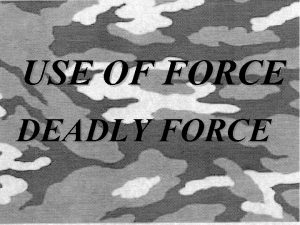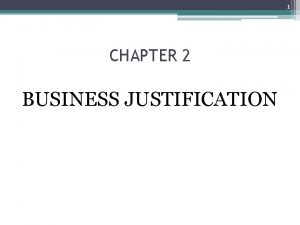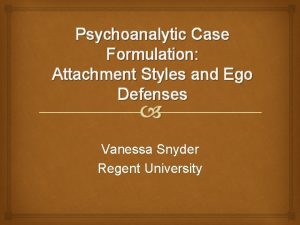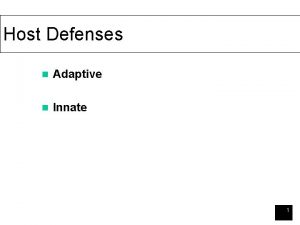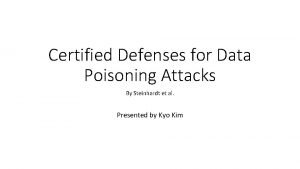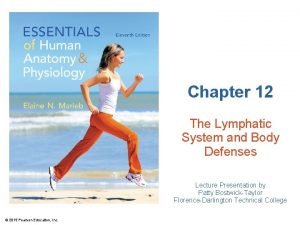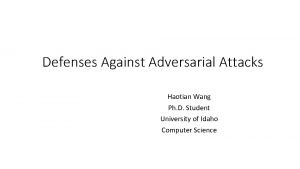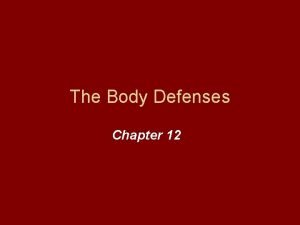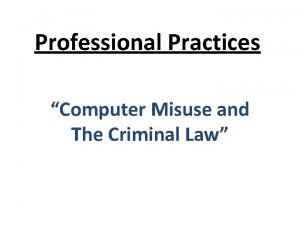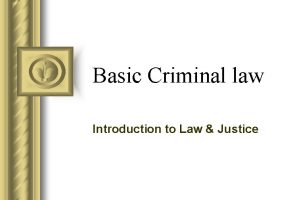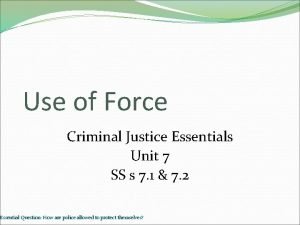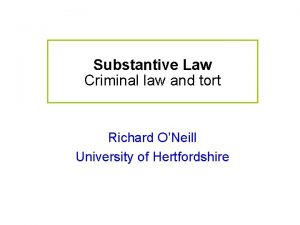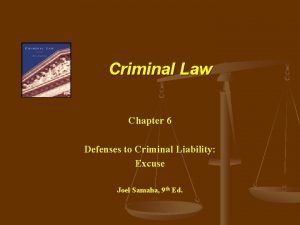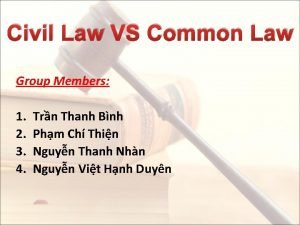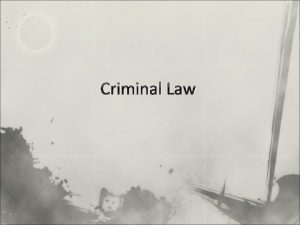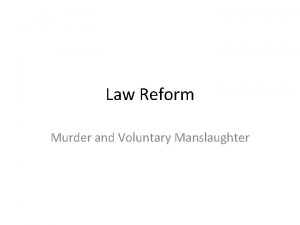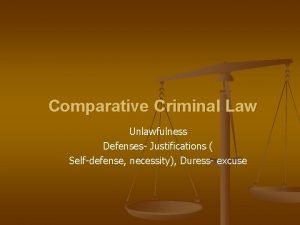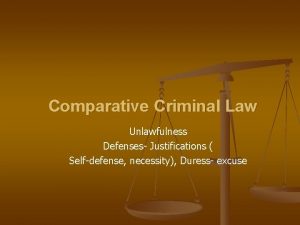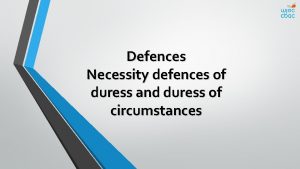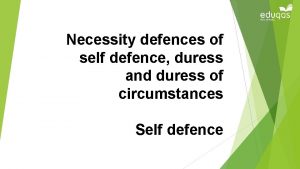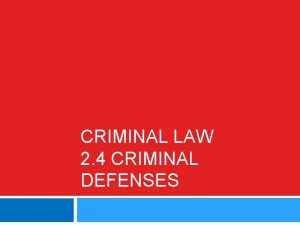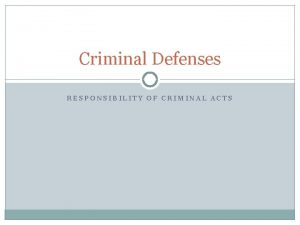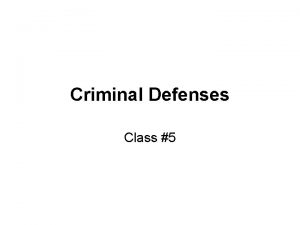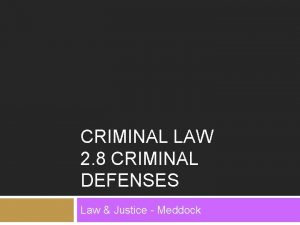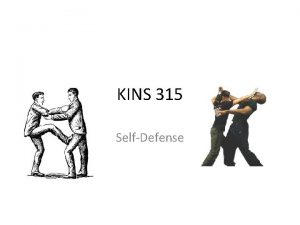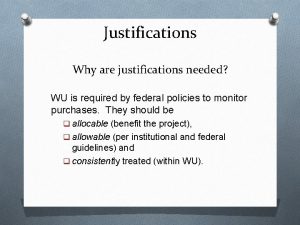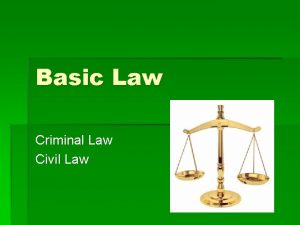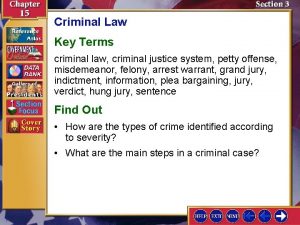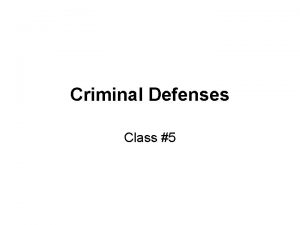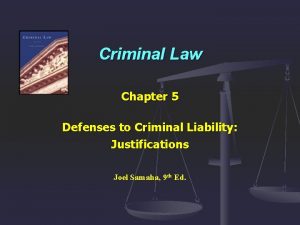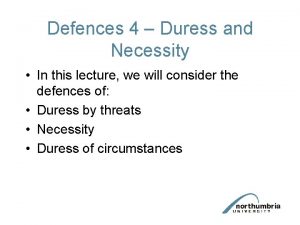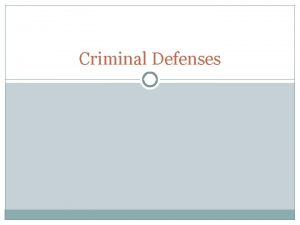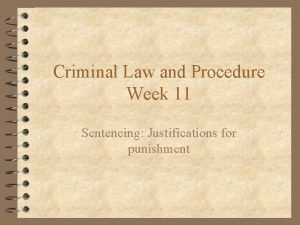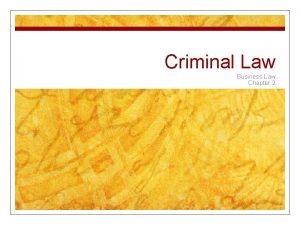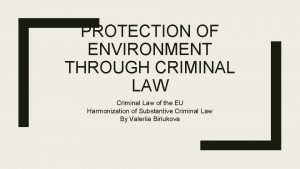Comparative Criminal Law Defenses Selfdefense necessity Justifications Duress


























- Slides: 26

Comparative Criminal Law Defenses Self-defense, necessity- Justifications, Duress- excuse

Defenses Justifications-Self-defense, necessity-, Duress- excuse n Defenses: A. Justifications: 1. 2. 3. B. self defense necessity consent Excuses … mistakes. . 1. Duress

A 1) Self-defense (US) n US (justification) n Common law elements: n n n 1. actual or apparent threat of death or serious bodily harm (proportionality) 2. threat is unlawful and immediate (imminence) 3. the response was necessary (necessity) 4. there is an honest and reasonable belief that deadly force was necessary Model Penal Code: n n Self-defense is justifiable when the actor believes that such force is immediately necessary for the purpose of protecting himself against the use of unlawful force by such other person on the present occasion. The difference between real self defense and putative self-defense or mistaken self-defense –Mistakes about Factual elements of Justification-Type three)? ?

People v. Goetz n The victims, Canty, Cabey, Ramseur and Allen and Bernard Goetz were traveling on a subway train in New York. Canty approached Goetz, possibly with Allen beside him, and said, “give me 5 dollars. ” None of the youths displayed a weapon. Goetz responded by standing up and firing four shots from his unlicensed pistol in rapid succession. A bullet struck each victim and the Goetz then shot Cabey again. Cabey’s spinal cord was severed in the attack, and he was paralyzed. The others fully recovered. Goetz claimed that he was certain that the youths did not have guns, but he was afraid, based on prior experiences, of being “maimed, ” because he had been mugged in the past.

State of Florida v. George Zimmerman n The 17 -year-old Trayvon Martin, who is black, was walking to a friend’s home in a gated community in Sanford, Florida, when a neighborhood-watch volunteer, 28 -year-old George Zimmerman, spotted him. Zimmerman called the police to report a suspicious person. They told him not to follow. “They always get away, ” Zimmerman told dispatch in a 911 call, and he kept tracking Martin. Zimmerman had a gun. Martin was carrying only an ice tea and Skittles he’d just bought at the store. The two had a struggle that no one saw. Hearing shots, neighbors called 911. In one call that’s hard to listen to, a woman anxiously says she can hear someone calling for help while in the background, a terrified, wailing voice pleads, “No! No!”. Zimmerman shot and killed Martin, but he said he did so in self-defense.

State of Florida v. George Zimmerman n n The two had a struggle that no one saw. Hearing shots, neighbors called 911. In one call that’s hard to listen to, a woman anxiously says she can hear someone calling for help while in the background, a terrified, wailing voice pleads, “No! No!”. Zimmerman shot and killed Martin, but he said he did so in self-defense. https: //www. msnbc. com/all-in/watch/jury-takes-the-caseof-state-of-florida-vs-george-zimmerman 37080643579? v=railb& https: //www. youtube. com/watch? v=Gl 1 GK 7 s 4 Lw. E https: //www. youtube. com/watch? v=onksj. Db. Vq. GI (audio)

A 1) Self-defense (US) n Departs from American law: n n n No retreat doctrines: n n n a) State v. Rama – any kind of assault is sufficient to respond with deadly force b) People v. Goetz - reasonable belief that the force used is necessary to protect oneself is sufficient 1. castle doctrine (old common law) - there is no duty to retreat from your home (it does not exempt person from duty to take flight when attacked in residence of another) 2. true man doctrine (e. g. Tennessee v. Renner) - "no duty to retreat" rule-one need not retreat from the threatened attack even though one may safely do so ( ‘Stand Your Ground’ Law) The requirement of imminence -there is no delay – „the time for the use of force will brook no delay” (Fl. 1998, 133)

A 1) Self-defense (US) Tennessee v. Renner n n Tennessee v. Renner (1995) After a jury trial, the defendant was convicted of first-degree murder in the shooting death of Greg Shuttles. On the evening of the shooting, Robert Renner was visiting with Micki Reynolds and her five-year-old son in their apartment. Renner and Reynolds had lived together but, at that time, were separated. Renner was there, ostensibly, to visit with the boy, with whom he was close. Shuttles, the victim, had spent the day in the apartment. Renner knew that Shuttles was there when Renner arrived, Shuttles was sitting on a couch watching television. …Reynolds accompanied Renner to the boy's room. After spending some time with the boy, Renner returned to the kitchen to get a Popsicle for the child and beer for himself. While there, he claims to have heard Shuttles load a firearm. Renner explained that he knew Shuttles was always armed; he testified also that he knew Shuttles was "high" on the evening in question. In light of this knowledge, Renner stated that when he heard Shuttles loading his firearm, he feared for his safety and pulled out his own firearm. He decided to leave; he passed through the living room to the front door. He claims that as he was making his way to the door Shuttles, reaching into his rear pocket, threatened to kill him. Seeing this movement, Renner shot Shuttles, who died as a result of the wounds. Hospital personnel removed a loaded firearm from Shuttles' rear pocket.

A 1) Self-defense (US) Tennessee v. Renner n n As stated, the Court of Criminal Appeals considered the issue and affirmed the conviction. The court was not, however, unanimous. Judge Paul G. Summers, who wrote for the "majority, " reasoned that the questions asked by the prosecutor on cross-examination of the defendant were relevant on the issue of credibility and did not suggest the existence of a duty to retreat. Judge Penny White, now Justice White, concurred in the "majority's" result, although on different grounds. She concluded that the questions and statements under discussion shed light on the issue of reasonableness of the force employed under the circumstances. Judge John L. Byers, former Presiding Judge of the Court of Criminal Appeals, dissented. He found, in essence, the prosecutor's argument to be that "a person must retreat before he is threatened. " This, Byers wrote, derogated the "no duty to retreat" rule and constituted reversible error. In 1989, the General Assembly added a "no duty to retreat" rule to the law of self-defense. This legislation, now codified in the Tennessee Code, provides: A person is justified in threatening or using force against another person when and to the degree the person reasonably believes the force is immediately necessary to protect against the other's use or attempted use of unlawful force. . There is no duty to retreat before a person threatens or uses force.

A 1) Self-defense; necessary defense (Germany) n n „The centerpiece of the defense is not life or safety as protectable interests but rather the legal sphere of the individual as defined by the range of personal rights” (Fl. 1998, 133) Criminal Code (§ 32) Self-defence n n n (1) A person who commits a required act in self-defence does not act unlawfully. (2) Self-defence means any defensive action that is necessary to avert an imminent unlawful attack on oneself or another. Criminal Code (§ 33) Excessive self-defence n A person who exceeds the limits of self-defence out of confusion, fear or terror shall not be held criminally liable.

A 1) Self-defense (Croatia) n n Criminal Code (Art. 21) (1) An act committed in self-defence shall not be unlawful. (2) A defence is deemed self-defence if it is absolutely necessary in order to avert a coinciding or imminent unlawful attack on oneself or another. (3) A perpetrator who exceeds the limits of self-defence may be punished less severely. (4) Whoever exceeds the limits of self-defence shall not be guilty if he/she has done so by reason of excusable great fear caused by the attack.

A 1) Self-defense (Croatia) n J. P. came to the house of the D. M. asking the defendant's mother at gunpoint to repay the owed money, because he will otherwise kill them all. Then he hit both of them with the grip of his gun, causing small injuries on their heads. By doing so, he dropped the container of ammunition, which he picked up from the floor and slowly, constantly trying to restore tank ammunition in the gun back, retrieting away towards the road. D. M. was trying to distract him from doing so. When they reached the pavement in front the house, while J. P. was still trying to restore the container into the gun to continue to attack, D. M. stabbed him, causing an upper relatively shallow injury of the left chest, after which the injured party finally managed to put the ammunition into the gun and fired one shot towards the D. M.

A 1) Self-defense n n Can we as homeowners kill a burglar for breaking into our private sphere? Art. 2. para 2. ECHR

A 2) Necessity (US) n n n Necessity = Choice of evils (justification) MPC: -harm done < harm or evil sought to be avoided -allows necessity defense to homicide Common law – injury avoided outweighs injury of the protected good -following Dudley & Stephens case, most U. S. jurisdictions don’t allow necessity as a defense to homicide

Dudley & Stephens case n n Dudley & Stephens (y. 1884) Facts: Dudley and Stephens along with Brooks and Parker(victim) were cast away at sea without weeks of food and water except for some turnips and a turtle. After twenty days, Dudley and Stephens proposed one person sacrifice himself in order to save the rest. Brooks dissented while Dudley and Stephens decided to kill Parker since he was the weakest and youngest. On the 25 th of July, seeing no rescue in sight, the two men killed Parker and the three men feasted on his body. Four days later a vessel rescued them and Dudley and Stephens were charged with murder. Issue: Whether the killing of Parker was murder considering the circumstances of this case. Killing an innocent life to save one’s own does not justify murder even if it under extreme necessity of hunger.

A 2) Necessity (Germany) n n n 1871 Criminal Code regulated necessity only as excuse German Supreme Court case (1927) A German physician ordered an abortion after he diagnosed a serious risk of suicide if the distraught mother were required to carry an apparently illegitimate child to term. The case had been tried twice, and both times the trial courts had acquitted the physician as well as the mother. "The concept of an offense requires both that the alleged conduct conform to the definition of the offense and that it be wrongful (rechtswidrig)” 1975 Criminal Code reform introduced necessity as justification, which was previously judicially developed as extrastatutory necessity

A 2) Necessity (Germany) n n n Criminal Code (§ 34) A person who, faced with an imminent danger to life, limb, freedom, honour, property or another legal interest which cannot otherwise be averted, commits an act to avert the danger from himself or another, does not act unlawfully, if, upon weighing the conflicting interests, in particular the affected legal interests and the degree of the danger facing them, the protected interest substantially outweighs the one interfered with. This shall apply only if and to the extent that the act committed is an adequate means to avert the danger.

A 2) Necessity (Germany) n n n German Civil Code § 228 Defensive necessity (attack on an object from which the danger arises). Anyone who damages or destroys a another’s property in order to avert a danger threatened to himself or another shall not be unlawful if the damage or destruction is necessary to avoid the danger and the damage is not disproportionate to the danger. § 904 Agressive necessity (attack on an object from which the danger does not arise). The owner of an object is not entitled to forbid the attack of another on the object if the action to avert a present danger is necessary and the imminent damage is disproportionately larger than the damage resulting from the attack on the owner’s property.

Daschner case n In October 2002, Daschner had threatened through police officer Ortwing Ennigkeit to inflict severe pain on Magnus Gaefgen, the kidnapper of 11 -year old banker’s son Jakob von Metzler, if Gaefgen did not reveal where he had hidden the child. Gaefgen promptly admitted that the boy was already dead. Gaefgen was later sentenced to life imprisonment for murder, and proceedings were initiated against Daschner for threatening torture and against police officer Ennigkeit. Daschner and Ennigkeit were sentenced to pay a fine, but which was deferred under warning.

Difference self-defense /necessity n n Self –defense: violence is always directed against aggressor Necessity: an invasion against interests and rights of a totally innocent party

B 1) Duress n n n Duress (excuse) n Common law elements: (1) a “threat of imminent death or serious bodily injury” led the defendant to commit the crime, (2) the defendant had no reasonable, legal alternative to breaking the law, and (3) the defendant was not responsible for creating the threat. duress applies to crimes other than murder n n n Model Penal Code: actor was coerced to do so by the use of, or a threat to use, unlawful force against his person or the person of another, if a person of reasonable firmness in actor’s situation would have not been able to resist.

B 1) Duress (Germany) n n n Criminal Code (§ 35) (1) A person who, faced with an imminent danger to life, limb or freedom which cannot otherwise be averted, commits an unlawful act to avert the danger from himself, a relative or person close to him, acts without guilt. This shall not apply if and to the extent that the offender could be expected under the circumstances to accept the danger, in particular, because he himself had caused the danger, or was under a special legal obligation to do so; the sentence may be mitigated pursuant to § 49(1) unless the offender was required to accept the danger because of a special legal obligation to do so. (2) If at the time of the commission of the act a person mistakenly assumes that circumstances exist which would excuse him under subsection (1) above, he will only be liable if the mistake was avoidable. The sentence shall be mitigated pursuant to § 49(1).

B 1) Necessity & Duress (Croatia) n n Criminal Code (Art. 22) (1) An act committed in order to avert from oneself or from another a coinciding danger which could not have been averted in any other way, provided that the harm resulting therefrom does not exceed the harm threatened, shall not be considered unlawful. -justification (2) Whoever commits an unlawful act in order to avert from himself/herself or from another a coinciding danger not brought on by himself/herself, which danger could not have been averted in any other way, provided that the resulting harm was not disproportionately greater than the harm threatened and that he/she was not required to expose himself/herself to the danger, shall not be guilty. If such a person was required to expose himself/herself to the danger, he/she may be punished less severely. -excuse (3) If the perpetrator was under an avoidable (mistake) delusion about the circumstances referred to in paragraph 2 of this Article which exclude guilt, he/she shall be punished according to the rules on negligence where the law prescribes punishment for the commission of an offence by negligence.

B 1) Croatian Supreme Court Case n In 1994 in the evening at a bar in Zagreb, there was a short quarrel and physical confrontation between A and B, during which A pushed the defendant B. Defendant B left the store and went to get automatic rifle. After 10 -20 minutes A and his underage son C left the bar. A drove with C in the direction of a bus stop. B stood nearby with an automatic rifle, and next to him was also D. B is pointing automatic rifle in the direction of oncoming cars, uttered the words 'stop, stop', and then the 15 meters fired a short burst of three shots of which two hit the right side metal frame of the windscreen. After B pointed the rifle towards the upcoming vehicle, A quickly turned the car towards B and D and ran into them at a speed of about 40 -45 km/h. Both suffered injuries. D’s role was to try to calm the defendant B, but he failed.

B 1) Croatian Supreme Court Case n Court of First Instance found B guilty of two criminal offenses of attempted murder and sentenced him to imprisonment for 1 year and 8 months (based on the individual established by imprisonment for a term of 1 year). By contrast, the defendant A was acquitted for two offenses of attempted murder, because the defendant B acted in self-defense, and to the D in the extensive excess of self defense that is in particular case justified by necessity. The Supreme Court court upheld the first instance verdict.

Thank you for your attention! Videos: http: //law. uc. edu/humanfactors. html
 Define genuine agreement
Define genuine agreement Under duress
Under duress Difference between civil law and criminal law
Difference between civil law and criminal law Difference between civil law and criminal law
Difference between civil law and criminal law Jefferson justifications worksheet
Jefferson justifications worksheet Deadly force justification navy
Deadly force justification navy Refers to the reasons, or justification, for a proposal.
Refers to the reasons, or justification, for a proposal. Ego defenses
Ego defenses Chapter 12 the lymphatic system and body defenses
Chapter 12 the lymphatic system and body defenses Host defenses
Host defenses Neur ips
Neur ips Certified defenses for data poisoning attacks
Certified defenses for data poisoning attacks Chapter 12 the lymphatic system and body defenses
Chapter 12 the lymphatic system and body defenses Nicolas papernot
Nicolas papernot Chapter 12 the lymphatic system and body defenses
Chapter 12 the lymphatic system and body defenses Computer misuse and criminal law
Computer misuse and criminal law Concurrence in criminal law
Concurrence in criminal law Taser 7 nomenclature
Taser 7 nomenclature Criminal law and juvenile justice unit 2
Criminal law and juvenile justice unit 2 Tort richard
Tort richard Criminal law samaha 9th
Criminal law samaha 9th Difference between civil and criminal law table
Difference between civil and criminal law table Difference between civil and criminal law table
Difference between civil and criminal law table Define substantive criminal law
Define substantive criminal law Diminished responsibility
Diminished responsibility Causation in criminal law
Causation in criminal law Diminished responsibility in criminal law
Diminished responsibility in criminal law





